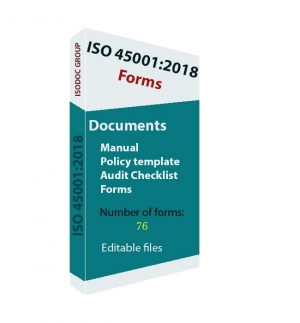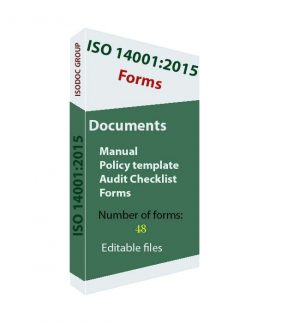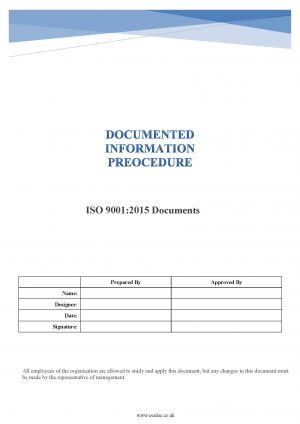Description
What documents does the integrated HSE management toolkit include?
This documentation includes Context of the Organization, Risk Assessment and Hazard Identification, Environmental Impact Assessment, Operational Control and Procedures, incident management procedures, Workplace Hazard Controls, Permit to Work Systems, HSE Compliance and Regulations, Resource and Waste Management Plans, Emergency Preparedness and Response, Corrective Action, Control of Contractors and Suppliers, Legal and Regulatory Requirements, internal audit procedure, HSE Performance and Evaluation Reports, and Continuous Improvement Process that all tailored to meet the requirements of both standards.
List of integrated HSE documentation toolkit
| No. | Document Name | Number of related forms or documents |
| 1 | HSE Policy | 1 |
| 2 | Process map | 1 |
| 3 | Process information | 19 |
| 1 | Context of organization procedure | 7 |
| 2 | Roles, and responsibilities procedure | 4 |
| 3 | Consultation and participation procedure | 3 |
| 4 | Risk and opportunity procedure | 3 |
| 5 | Hazard identification and assessment procedure | 4 |
| 6 | Environmental aspects procedure | 4 |
| 7 | Legal requirements procedure | 3 |
| 8 | HSE management system objectives procedure | 4 |
| 9 | Resource management procedure | 3 |
| 10 | Calibration and laboratory procedure | 6 |
| 11 | Competence and awareness procedure | 9 |
| 12 | Communication procedure | 3 |
| 13 | Documented information procedure | 6 |
| 14 | OH&S control procedure | 12 |
| 15 | Environmental control procedure | 6 |
| 16 | Supplier and procurement procedure | 11 |
| 17 | Emergecy situation response procedure | 8 |
| 18 | Monitoring, measurement and analysis procedure | 4 |
| 19 | Compliance evaluation procedure | 2 |
| 20 | Internal audit procedure | 5 |
| 21 | Management review procedure | 4 |
| 22 | Nonconformity and corrective action procedure | 4 |
| 23 | Incident investigation and reporting procedure | 3 |
| 24 | Continual improvement procedure | 2 |
| 1 | Emergency response instruction | 1 |
| 2 | Fire extenuating instruction | 1 |
| 3 | Fishbone techniques | 1 |
| 4 | Technique 5 why | 1 |
What is an HSE integrated management system?
An HSE Integrated Management System (IMS) is a unified framework that combines the management of Health, Safety, and Environmental (HSE) aspects within an organization. This system is designed to streamline processes and enhance overall performance by integrating the requirements of the Environmental Management System (ISO 14001) and the Occupational Health and Safety Management System (ISO 45001). The integration of these standards helps organizations improve compliance, manage risks, and foster a culture of continuous improvement in health, safety, and environmental performance within the organization and related stakeholders.
Purpose of the HSE Integrated Management System
The purpose of the HSE Integrated Management System (HSE IMS) is to evaluate, mitigate, and control potential environmental impacts and occupational health and safety risks in compliance with applicable laws and relevant regulatory standards, with a commitment to the continuous improvement of HSE performance.
Requirements for Implementing an HSE Integrated Management System
The successful implementation of an HSE IMS requires meeting several key requirements that align with the principles of ISO 14001 and ISO 45001. These requirements include Leadership and Commitment, where top management must demonstrate a strong commitment to HSE management by setting HSE objectives aligned with the organization’s strategic direction and providing necessary resources for implementation, as well as establishing an Integrated HSE Policy that outlines the organization’s commitment to health, safety, and environmental protection. Additionally, organizations must conduct thorough Risk and Opportunity Assessments, develop SMART objectives, provide adequate support and resources, implement effective Operational Control, and establish Monitoring and Measurement processes to evaluate HSE performance, all while ensuring regular Internal Audits and Management Reviews are conducted to assess effectiveness and facilitate Continuous Improvement.

How to Implement and Deploy an HSE Integrated Management System
The implementation of the integrated HSE system involves several steps that are systematically planned by the ISO-HSE consultant. These steps are then executed, maintained, and improved with the active involvement and participation of the organization’s managers and experts.
The implementation steps of the integrated HSE system encompass the following activities:
Comprehensive Assessment:
Conduct a thorough analysis of the organization’s business, processes, products, and services to identify the extent of deviation from ISO 14001 and ISO 45001 standards.
Documentation Design and Development:
Design and develop comprehensive documentation, including policies, procedures, instructions, forms, audit checklists, communication matrices, and other relevant materials.
The implementation of the system includes the following activities:
Identification and Updating of Legal and Regulatory Requirements,
Measurement of Occupational Hazards and Environmental Pollutants,
Determining environmental factors,
Roles and Responsibilities Definition,
Identifying, evaluating and controlling the risk of occupational and environmental hazards
Policy and Objectives Setting,
Operational Control,
Emergency Response System Creation,
Incident Reporting,
Compliance Evaluation,
Corrective Actions Implementation,
Monitoring and Data Analysis,
Internal Audits,
Management Review Meetings,
Safety and Environmental Certification Audits,
Application of the HSE Integrated Management System
An HSE IMS is applicable across a wide range of industries and sectors, including manufacturing, construction, energy, healthcare, and services. Organizations of all sizes can benefit from implementing an HSE IMS, particularly those that face significant health, safety, and environmental risks. Specific applications include:
- Manufacturing: Enhancing workplace safety and reducing environmental impact through better waste management and hazardous materials handling.
- Construction: Managing safety risks on construction sites while minimizing environmental impacts such as noise, dust, and waste.
- Energy Sector: Mitigating risks associated with hazardous operations, such as oil and gas extraction, and reducing environmental pollution.
- Healthcare: Protecting healthcare workers from occupational hazards and minimizing the environmental impact of medical waste and chemicals.
- Service Industries: Ensuring compliance with HSE regulations in industries such as hospitality, retail, and transportation, while improving operational efficiency.
A prerequisite for the establishment of an HSE-integrated management system
For the successful deployment of an HSE IMS, several conditions must be met:
- Management Commitment: Strong commitment from top management is essential to provide the necessary resources, drive the implementation process, and promote a culture of health, safety, and environmental responsibility.
- Employee Involvement: Employees at all levels must be involved in the HSE IMS, from participating in risk assessments to following established procedures. Their engagement is critical to the system’s success.
- Clear Communication: Effective communication is necessary to ensure that everyone in the organization understands the HSE IMS objectives, policies, and procedures.
- Resource Allocation: Adequate resources, including financial, human, and technological, must be allocated to support the development, implementation, and maintenance of the HSE IMS.
- Compliance with Regulations: The HSE IMS must be designed to meet all applicable legal and regulatory requirements related to health, safety, and environmental management.

Documentation of the HSE Integrated Management System (ISO 14001 & ISO 45001)
Proper documentation is a critical component of an HSE IMS. The documentation should include:
- Integrated HSE Processes: Identifying and determining the sequence and interaction between processes including inputs, outputs, activities, process performance indicators, responsibility, and authority.
- Processes and Objectives: Determining the scope of the HSE management system, policy, and objectives of the HSE IMS.
- Process Documentation: Detailed documentation of integrated processes, such as risk assessments, incident reporting, training, and audits.
- Records Management: Maintenance of records related to health, safety, and environmental activities, including audit reports, incident logs, compliance records, and training records.
- Procedures and Work Instructions: Clear and concise procedures and work instructions that guide employees in performing their tasks in compliance with the HSE IMS.
- Legal and Regulatory Compliance: Documentation of compliance with relevant health, safety, and environmental regulations, including permits, licenses, and inspection reports.
Deployment Obstacles
Deploying an HSE IMS can present several challenges and obstacles, including:
- Resistance to Change: Employees and management may resist changes in processes and procedures, particularly if they are accustomed to separate systems for health, safety, and environmental management.
- Resource Limitations: Implementing an integrated system may require significant investment in terms of time, personnel, and finances, which can be challenging for some organizations.
- Complexity of Integration: Integrating the requirements of ISO 14001 and ISO 45001 into a single system can be complex, particularly in large organizations with diverse operations.
- Lack of Expertise: A lack of internal expertise in health, safety, and environmental management can hinder the effective implementation of the HSE IMS.
- Balancing Priorities: Balancing the priorities of health, safety, and environmental management can be difficult, especially when resources are limited or when one area is perceived as more critical than the others.
The duration of the HSE integrated management system
The duration of implementing an HSE IMS can vary depending on the size and complexity of the organization, as well as the current state of its management systems. Typically, the implementation process can take anywhere from 6 to 18 months:
- Small Organizations: For small organizations with relatively simple operations, the implementation process may take around 6 to 9 months.
- Medium-sized Organizations: For medium-sized organizations with more complex operations, the process may take 9 to 12 months.
- Large Organizations: For large organizations with multiple locations or highly complex operations, the implementation may take 12 to 18 months or longer.
- Also, as part of the implementation and deployment, the duration of the documentation of the integrated HSE management system may take 2 to 3 months depending on the size, complexity of the processes, and the level of knowledge of the organization’s employees.
Cost of implementation and deployment Integrated HSE management system
The cost of implementing and deploying an HSE IMS depends on several factors, including the size of the organization, the complexity of its operations, and the level of external support required. Key cost components include:
- Consultancy Fees: External consultants may be hired to assist with the gap analysis, policy development, training, and audit preparation. Consultancy fees can range from $10,000 to $150,000 depending on the scope of work and the consultant’s expertise.
- Training Costs: Employee training on the integrated system is essential. Training costs can vary based on the number of employees and the type of training required, typically ranging from $5,000 to $50,000.
- Internal Resource Allocation: The cost of internal resource allocation, such as time spent by employees and management on the implementation, should be considered. This cost is often reflected in lost productivity during the implementation phase.
- Certification Costs: Obtaining ISO 14001 and ISO 45001 certification involves audit fees and certification body fees. Certification costs can range from $5,000 to $25,000 per certification, depending on the organization’s size and complexity.
- Documentation and Software: Costs associated with developing documentation, purchasing software for managing the HSE IMS, and maintaining records can vary widely, from $2,000 to $30,000.
Conclusions about this integrated HSE documentation toolkit
Unlock the full potential of your organization with our comprehensive HSE Integrated Management System (IMS) documentation toolkit. Designed to simplify and streamline the implementation of ISO 14001 and ISO 45001 standards, this essential resource provides everything you need—from detailed policies and procedures to risk assessments and audit protocols. Whether you’re looking to enhance compliance, boost efficiency, or ensure a safer, more sustainable workplace, our expertly crafted HSE documentation will guide you every step of the way, saving you time and reducing complexity. Start your journey towards seamless HSE integration today!





Selin alhansavi –
Hi, With using this toolklt we could established easily HSE system in our company because every things have explained clearly, Thanks